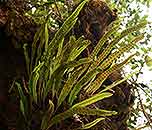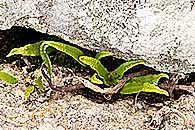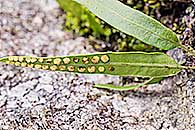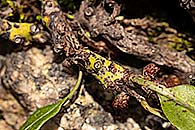Lepisorus schraderi (Mett.) Ching
Synonyms |
Pleopeltis schraderi (Mett.) Tardieu |
|---|---|
Common name |
|
Description |
Rhizome c. 2 mm in diameter, creeping, without a white waxy colouring; rhizome scales black, broadly ovate in outline, apex pointed, 2-3 mm long, with black central stripe extending to the apex. Fronds spaced apart (up to 1 cm), simple, thick and fleshy, tufted, evergreen. Stipe up to 6 cm long, strawcoloured, glabrous. Lamina up to 34 × 2.9 cm, narrowly elliptic, tapering to a point, base narrowly wedge-shaped, margins entire, glabrous on both surfaces at maturity. Sori round to oval, 2-6 mm in diameter, in a line on either side of the midrib in the upper half of the lamina, exindusiate, but with small paraphyses when young. |
Notes | Can be distinguished from L. excavatus by having thick, evergreen fronds and a rhizome that lacks a white, waxy coating. Pleopeltis macrocarpa has small circular scales with dark centres on the undersurface of the lamina, these are not present in L. schraderi. Microgramma mauritiana has sori set on the lower part of the lamina (not the upper) and is glabrous. |
Derivation | schraderi: named after H.A. Schrader (1767-1836); former director of botanical garden in Goettingen Germany, botanist with special interest in ferns. |
Habitat | Evergreen forest or scrub, lower upland forest, cedar forest, in areas of high rainfall, mostly shaded. |
Distribution worldwide | |
Distribution in Africa |
Ethiopia, Kenya, Malawi, Mozambique, Rwanda, South Africa, Swaziland, Tanzania , Uganda, Zambia, Zimbabwe. |
Growth form |
Epiphytic, lithophytic. |
Literature |
|







